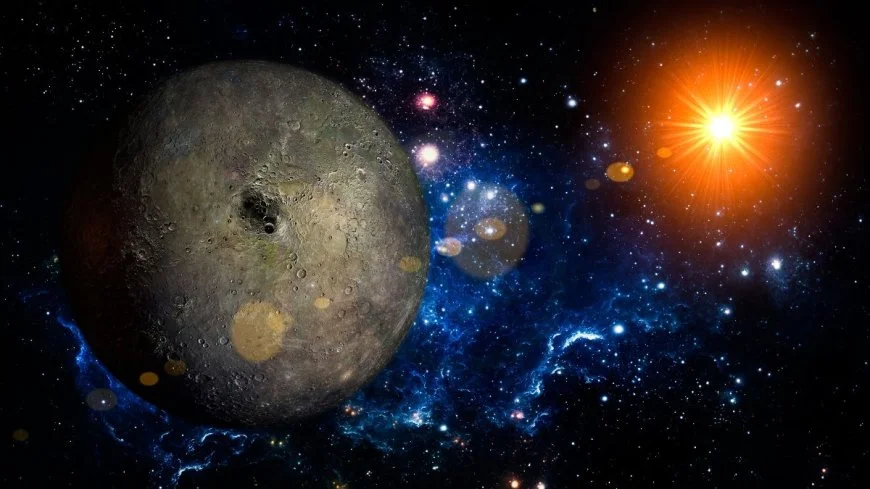Which Planet in the Solar System is Least Dense? Understanding Density & Saturn's Composition
Discover the least dense planet in the solar system and understand its composition. Explore density variations among the planets.

Did you know that despite its massive size of 74,900 miles equator and a mass of 5.68 x 10^26 kg, Saturn is the least dense planet in our solar system? This gas giant's density is so low that it could float on water! Surprisingly, even though Earth is much smaller than Saturn, our planet has a significantly higher density due to its solid composition. Understanding the densities of planets can provide valuable insights into their unique characteristics and compositions. Exploring why Saturn, with its mesmerizing rings and swirling storms, defies expectations by being the least dense planet unveils fascinating facts about our celestial neighborhood
Key Takeaways
- Consider Density: Understand that density is a crucial factor in planetary composition and can vary significantly across celestial bodies.
- Identify the Least Dense Planet: Explore the densities of different planets in the solar system to determine that Saturn is the least dense due to its composition and structure.
- Saturn's Unique Composition: Saturn's low density is attributed to its predominantly gaseous nature, particularly being composed of hydrogen and helium.
- Implications of Low Density: The low density of Saturn influences its overall mass and volume, impacting its gravitational pull and structural characteristics.
- Actionable Insight: When studying planetary properties, focus on density as a key indicator of composition and structural makeup, especially when comparing celestial bodies within the solar system.
- Future Research Directions: Further research can delve into how the unique composition and low density of Saturn contribute to its distinct features and behavior in the solar system.
Understanding Density
Basic Concepts
Density in planetary science refers to the mass of a planet divided by its volume. This measurement helps scientists understand the composition and structure of celestial bodies. Relative density compares the density of different planets to determine their internal makeup.
Why is density crucial in planetary studies? It provides insights into a planet's formation, evolution, and composition. Understanding density helps scientists classify planets based on their materials, such as rocky or gaseous compositions.
Density in Space
Across various celestial bodies, density varies significantly. For example, gas giants like Jupiter have low densities due to their gaseous nature. In contrast, terrestrial planets like Earth have higher densities because of their solid composition.
The significance of density in space exploration lies in identifying potentially habitable worlds. By analyzing density, scientists can predict a planet's surface conditions and potential for supporting life forms. Additionally, it aids in understanding the gravitational forces acting on different planets.
Measuring Techniques
To measure planetary densities, scientists utilize methods like gravitational field analysis and spacecraft data collection. These techniques provide valuable information about a planet's internal structure and composition.
Comparing measurement techniques reveals variations in accuracy and precision when determining planetary densities. Gravitational field analysis, for instance, offers indirect measurements based on gravitational interactions with other objects.
Challenges persist in accurately measuring densities due to factors like irregular shapes and complex compositions of celestial bodies. Technological advancements have improved measurement precision through advanced instruments onboard spacecraft missions.
Solar System Overview
Planetary Profiles
Mercury, the closest planet to the Sun, is known for its extreme temperatures. Venus, shrouded in thick clouds of sulfuric acid, experiences a runaway greenhouse effect. Earth, our home planet, has a diverse range of ecosystems and supports abundant life. Mars, often called the "Red Planet," shows evidence of past water flow.
Jupiter, the largest planet, boasts a massive storm called the Great Red Spot. Saturn is famous for its stunning ring system composed of ice particles and rocks. Uranus rotates on its side, giving it unique seasonal patterns. Neptune, with its deep blue coloration, experiences incredibly strong winds.
Composition Insights
Planets are composed of various materials such as rock, metal, ice, and gas. The composition directly influences a planet's density. For example, rocky planets like Earth have higher densities compared to gas giants like Jupiter due to their solid composition. The presence of heavy elements like iron increases a planet's density.
Different materials lead to varying densities; for instance, gas giants have low densities due to their gaseous nature. The core composition also plays a crucial role in determining overall density. Planets with denser cores tend to have higher average densities.
Density Variances
Planetary densities vary due to factors such as size, composition, and formation history. Larger planets tend to have higher densities because gravity compresses their interiors more effectively. The formation process also affects density; planets that formed closer to the Sun often have higher densities than those farther away.
Factors like core temperature and pressure influence density variations among planets. Density variations provide clues about a planet's past, including its formation conditions and evolutionary history. By studying these variances, scientists gain insights into the processes shaping planetary bodies.
Densities of Planets
Earth and Mars
Earth, the third planet from the Sun, has a density of approximately 5.52 grams per cubic centimeter. In contrast, Mars, the fourth planet, boasts a density of around 3.93 grams per cubic centimeter. These differences in density are reflective of their respective compositions. Earth's higher density is due to its iron-nickel core, while Mars has a less dense composition with a smaller iron core.
The densities of Earth and Mars play a crucial role in shaping their geological structures and atmospheres. With its higher density, Earth possesses a robust magnetic field that shields it from solar winds and cosmic radiation. On the other hand, Mars' lower density contributes to its lack of a global magnetic field, leaving its thin atmosphere vulnerable to space weather.
- Similarities:
- Both planets have rocky surfaces.
- Differences:
- Earth has a denser core compared to Mars.
Jupiter and Saturn
Jupiter, the largest planet in our Solar System, has a density of approximately 1.33 grams per cubic centimeter. In stark contrast, Saturn's density is notably lower at around 0.69 grams per cubic centimeter, making it the least dense planet in our system. Saturn's low density is primarily attributed to its composition of hydrogen and helium gases, which give it its distinct ring system.
Saturn's unique characteristic as the least dense planet stems from its predominantly gaseous nature, unlike Jupiter which has a denser core beneath its gaseous layers. This difference in density between Jupiter and Saturn showcases the diverse range of planetary compositions within our Solar System.
- Unique Characteristics:
- Saturn's rings are composed mainly of ice particles.
- Contrast:
- Saturn is less dense than Jupiter due to its gaseous composition.
Uranus and Neptune
Uranus and Neptune are classified as ice giants due to their relatively low densities compared to gas giants like Jupiter and Saturn. Uranus has a density of about 1.27 grams per cubic centimeter, while Neptune boasts a slightly higher density at around 1.64 grams per cubic centimeter.
The densities of Uranus and Neptune contribute significantly to their classification as ice giants because they consist largely of elements such as water, ammonia, and methane in various forms of ice along with rock and metal at their cores. Understanding these densities provides insights into the unique compositions and structures of these distant planets within our Solar System.
- Classification:
- Both Uranus and Neptune are categorized as ice giants.
- Significance:
- Density helps reveal the internal makeup of these planets.
Identifying Least Dense
Comparative Analysis
When comparing planetary densities, it's evident that Mercury is the densest planet in our solar system. Venus follows, being slightly less dense than Mercury. Earth stands out with a moderate density due to its diverse composition of rocks, water, and gases. Mars, known for its red color, has a lower density compared to Earth. Jupiter, the largest planet, has a relatively low density due to its composition of hydrogen and helium gases.
The variations in planet densities are crucial as they directly influence the planets' structures and compositions. Planets with higher densities tend to have more solid materials like rocks and metals, leading to compact structures. In contrast, planets with lower densities often consist of lighter elements like gases or icy materials. This difference in composition impacts various planetary features such as size, gravity, and even surface conditions.
Density plays a significant role in categorizing planets based on their characteristics. It helps astronomers classify planets into different groups based on their physical properties. For instance, terrestrial planets like Earth are characterized by higher densities due to their rocky compositions. On the other hand, gas giants like Jupiter and Saturn have lower densities attributed to their predominant gas content.
Saturn's Uniqueness
Saturn stands out among the planets in our solar system due to its unique density characteristics. With an average density lower than water, Saturn is one of the least dense planets known. This intriguing feature gives Saturn the peculiar quality of being able to float if placed in a massive enough body of water—a fascinating concept considering it's a giant gas planet.
The low density of Saturn is primarily attributed to its composition dominated by hydrogen and helium gases. Unlike rocky planets that have solid surfaces, Saturn's gaseous nature contributes significantly to its overall low density level. This distinctive characteristic sets Saturn apart from other planets in the Solar System by showcasing a different structural makeup and physical behavior.
Saturn's Composition
Gaseous Nature
Gas giants like Saturn have low density due to their predominant gaseous composition. Unlike terrestrial planets, gas giants lack solid surfaces, contributing to their lower overall density. The gravitational pull of these planets is not strong enough to retain heavier elements, resulting in a lighter composition.
The low density of gas giants significantly impacts their atmospheric composition. Saturn, being the least dense planet in the solar system, consists mainly of hydrogen and helium gases. These light elements contribute to its overall low density compared to other planets. The absence of a solid surface allows for the accumulation of vast amounts of gases.
Atmospheric Layers
Density plays a crucial role in determining the atmospheric layers present on planets. Variations in density lead to the formation of distinct layers within a planet's atmosphere. Gas giants like Saturn exhibit complex atmospheric dynamics due to stark differences in density throughout their atmospheres.
The relationship between density and atmospheric layers influences the atmospheric dynamics of planets significantly. In the case of Saturn, its upper atmosphere consists mainly of hydrogen and helium, while deeper layers may contain heavier compounds like water vapor and ammonia. These varying densities create unique atmospheric conditions within gas giants.
Density Comparison
Saturn vs Jupiter
Saturn and Jupiter, the two largest planets in our solar system, exhibit significant differences in density. Jupiter is denser than Saturn, with a density of 1.33 grams per cubic centimeter, while Saturn has a lower density of 0.69 grams per cubic centimeter. These variations in density stem from their compositions and internal structures.
The higher density of Jupiter indicates a larger core made up of heavy elements like rock and metal, surrounded by layers of hydrogen and helium. In contrast, Saturn has a less dense core primarily composed of ice and rock, contributing to its lower overall density. These differences in composition influence the planets' gravitational forces and magnetic fields.
The distinct densities of Saturn and Jupiter directly impact their internal structures. Jupiter's higher density results in a more compact core, leading to greater gravitational compression within the planet. On the other hand, Saturn's lower density allows for a less compressed core, influencing its magnetic field strength and atmospheric dynamics.
The disparities in density between Saturn and Jupiter contribute to their unique characteristics as gas giants. While Jupiter's higher density influences its intense magnetic field and rapid rotation, Saturn's lower density affects its extensive ring system and diverse moons. These variations showcase how density plays a crucial role in shaping planetary features.
Terrestrial Planets
When comparing the densities of terrestrial planets like Mercury, Venus, Earth, and Mars to gas giants such as Jupiter and Saturn, notable differences emerge. Terrestrial planets have significantly higher densities compared to gas giants due to their solid compositions.
The terrestrial planets' higher densities result from their rocky surfaces and metallic cores, unlike the predominantly gaseous compositions of gas giants. This disparity in composition leads to variations in gravitational pull and surface features on these planets.
The relationship between density and surface features on terrestrial planets is evident through phenomena like crater formations on Mercury's dense surface or the volcanic activity on Mars due to its iron-rich composition. These examples highlight how varying densities shape the geological processes occurring on terrestrial planets.
Implications of Low Density
Habitat Unlikelihood
Low planetary density significantly impacts habitability, limiting the likelihood of supporting life. Planets with low densities lack the necessary gravitational pull to maintain a stable atmosphere. This affects temperature regulation and the retention of essential elements for life. The inability to support liquid water due to low density further diminishes the chances of hosting life forms. Density plays a crucial role in determining a planet's potential habitability, as it influences various environmental factors critical for sustaining life.
Ring Formation
The relationship between planetary density and ring formation is intricate. Variations in density directly affect the formation and stability of planetary rings. Planets with lower densities are more prone to gravitational disruptions, which can lead to the disintegration of ring systems over time. Density variations impact the gravitational interactions within ring structures, influencing their composition and longevity. Understanding how density influences ring formation provides valuable insights into the dynamics of planetary systems.
Future Research Directions
Advanced Measuring
Planetary densities are crucial in understanding celestial bodies. Advanced techniques like gravimetry and radiography offer precise density measurements. These methods utilize gravitational field variations and X-ray imaging to determine densities accurately. Technological advancements have significantly enhanced the accuracy of density measurements, providing valuable insights into planetary compositions.
In the future, advanced measuring techniques will continue to revolutionize planetary science. By improving measurement precision, scientists can unravel mysteries surrounding celestial objects' internal structures. These advancements pave the way for deeper exploration of planetary compositions and physical characteristics. The evolution of measuring technologies promises groundbreaking discoveries in the field of planetary science.
Exploration Missions
Density measurements play a pivotal role in space exploration missions. Understanding planetary densities is essential for mission planning and execution. Data obtained from these missions provide vital information for designing spacecraft trajectories and landing procedures. Density data from exploration missions contribute significantly to expanding our knowledge of the Solar System's diverse landscapes.
Exploration missions not only enhance our understanding of planetary densities but also shed light on the geological processes shaping celestial bodies. By analyzing density variations across different regions, scientists gain insights into the formation and evolution of planets. The data collected during these missions serve as valuable resources for further research and exploration endeavors.
Final Remarks
You've delved into the depths of planetary densities, discovering Saturn as the least dense planet in our solar system. Understanding these scientific intricacies sheds light on the unique composition and characteristics of each celestial body. As you ponder the implications of low density on Saturn's structure and formation, consider how future research can unveil more mysteries about this gas giant.
Exploring the densities of planets not only enriches your astronomical knowledge but also sparks curiosity about the vast universe surrounding us. Embrace the wonder of space exploration and continue to seek answers to the celestial puzzles that intrigue you. Keep looking up at the night sky; who knows what other secrets it holds for you to uncover.
Frequently Asked Questions
What is density and why is it important in planetary science?
Density refers to how much mass is contained in a given volume. In planetary science, density helps scientists understand the composition and internal structure of celestial bodies, providing insights into their formation and evolution.
How do scientists determine the density of planets in the solar system?
Scientists calculate a planet's density by dividing its mass by its volume. Mass can be estimated using gravitational interactions with other celestial bodies, while volume is determined based on the planet's size or radius.
Which planet in our solar system has the lowest density?
Saturn is the least dense planet in our solar system. Despite being a gas giant, its average density is lower than that of water due to its predominantly gaseous composition and low overall mass compared to its size.
What are the implications of a planet having low density?
A low-density planet typically indicates a composition rich in lighter elements like hydrogen and helium. This can influence factors such as gravitational pull, atmospheric properties, and overall geophysical processes on the planet.
What's Your Reaction?







































![MacBook Pro M5: All the features and specs you need to know [LEAKS REVEALED]](https://tomsreviewbox.com/uploads/images/202502/image_430x256_67bd6d7cd7562.jpg)



























